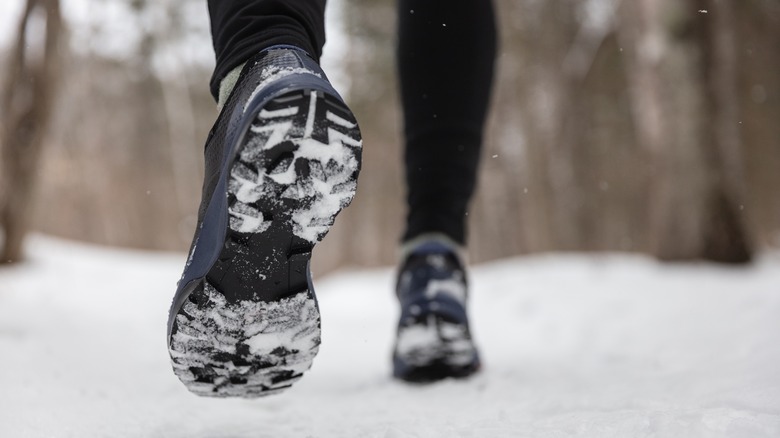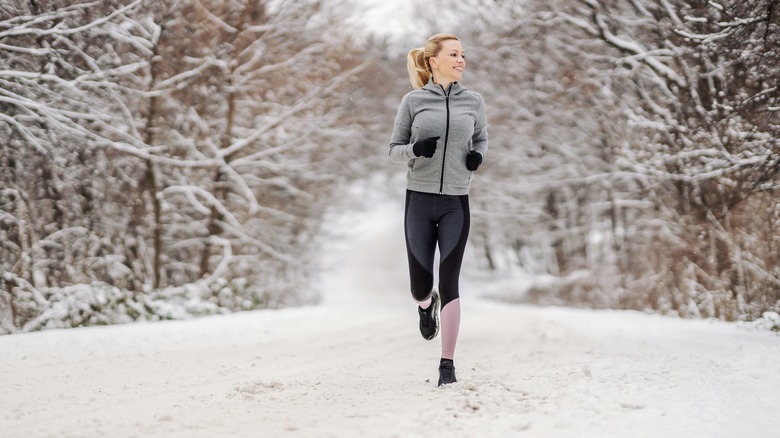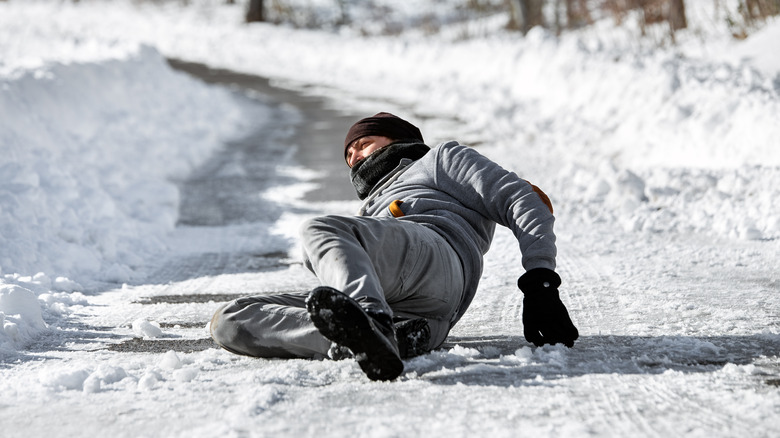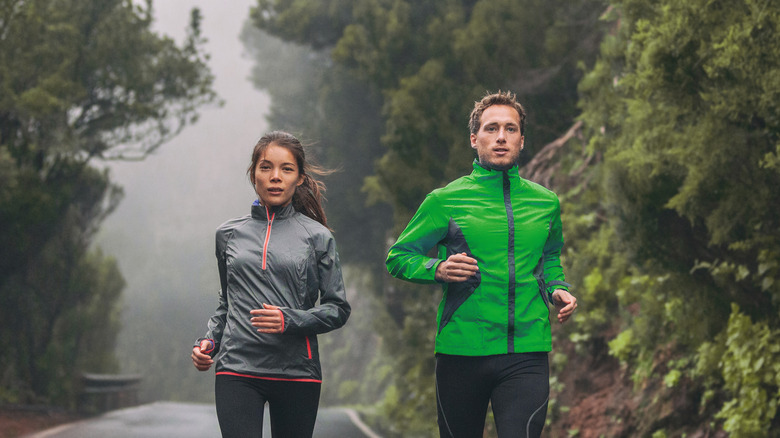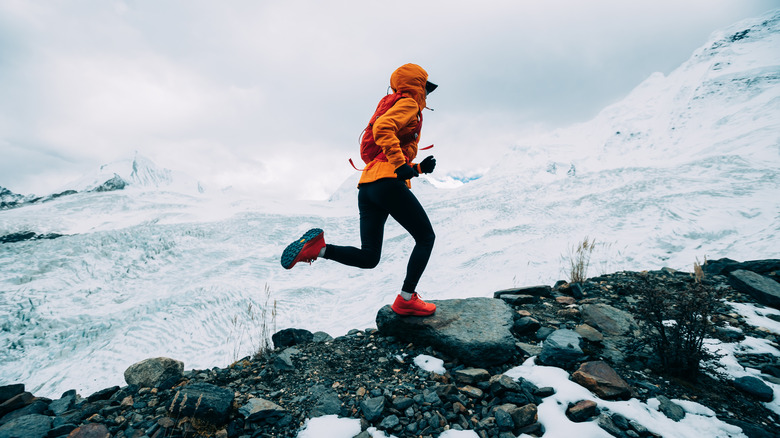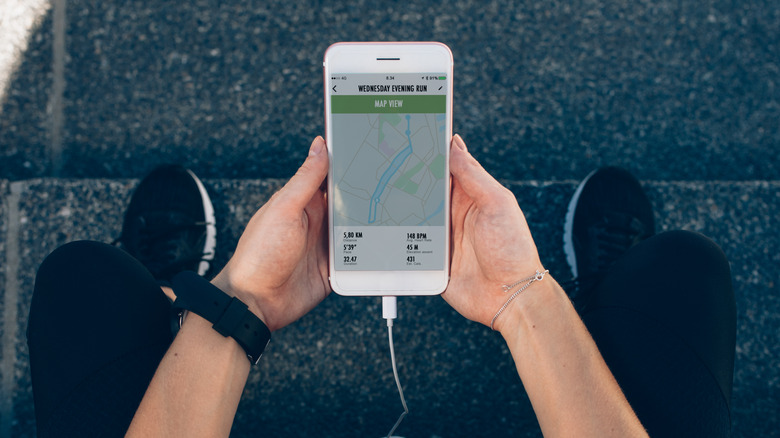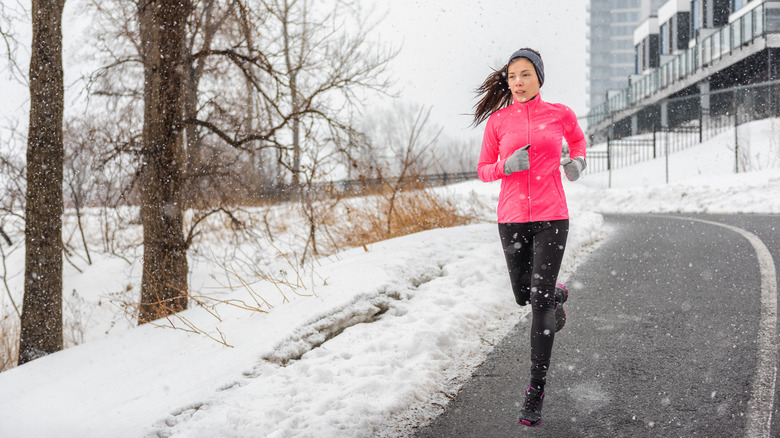Tips For Running In Winter's Cold Weather
One second, it's summer: The birds are chirping in the trees, the evenings seem to stretch on forever — and if you're a runner, you're pounding down the pavement, sun on your back, light T-shirt flapping in the breeze. And then suddenly (boom!) it's winter again. Enter frosty mornings, snowy dusks, and a significantly less inviting running environment.
Running in cold weather can be a hard sell at the best of times, with bone-chilling temperatures giving many people pause before they put on their sneakers. And despite the significant benefits of running in cold environments, with the frosty conditions potentially causing an increase in metabolic activity and more calorie burn, it's all too easy to just stay at home and skip that jog (per Healthline).
But, folks, it needn't be this way. While it can be more challenging to convince yourself to run in winter's cold weather, with a few adjustments to your approach, you can still get your workout in, while remaining comfortable and safe. Let's take a look at our top tips for running in cold weather.
Make sure you warm up thoroughly
Most runners will attest to the sheer discomfort of starting a jog before you're warmed up. But warming up properly does more than just make your run easier. "Without a proper warm-up, you are increasing your potential risk of injury while also missing out on the benefits of increasing your mobility," says Aubrey Watts, certified strength and conditioning specialist, via SELF. In colder weather, your body will not only be chillier before starting but will take far longer to come up to temperature when running, which could exacerbate your risk of injury, and leave you feeling seriously uncomfortable in the opening stages of your exercise.
So, make sure you warm up before you start your run, ideally inside. The best way to do this is by engaging the muscles you'll be using during your run with active moves and dynamic stretches (per Runner's World). Start with a finger crusher move, which activates your abs and hip flexors, and then move on to a glute bridge. Then, work into your ankles and calves by rolling through your feet, followed by a walking lunge to wake up your larger lower body muscles, and then finish with a hamstring sweep, which awakens your posterior chain. Move through the sequence twice, and then hit the road!
Pick the right types of clothes
As we all know, when it gets cold, what you wear when you leave the house becomes essential. And it's doubly important if you're heading out to exercise. Naturally, when you're going for a run in freezing cold weather, you're going to want to dress warm, and the best way to do this is by layering your clothes, explains Brigham Health Hub. Layering up with a series of lighter clothes will not only help you trap heat in but release it as your body warms up through your run, and you shed the outer clothes.
When it comes to running garments, the right fabric is everything. Opt for a sweat-wicking fabric made of synthetic materials for the bottom layer, which will allow you to stay dry, and retain heat more effectively. On the outer layer, you should wear something relatively light and breathable, like GORE-TEX, which will allow you to release unnecessary heat and keep you comfortable. As much as possible, try and avoid wearing cotton. While it's comfortable to wear when you're not running, cotton has an uncanny ability to hold on to sweat and get weighed down, which leads to damp and overly warm conditions (via Runners Need). Wearing cotton can also lead to chafing.
Be careful of the ice
Running in cold weather can be a bracing experience, but there are times when things can get a little too hairy — or in this case, icy. And when it's icy out, you must remain vigilant. Running on ice, as well as snow, can make your running path far more hazardous, and make the chance of falling and sustaining an injury far greater (per the Cleveland Clinic). There can also be a tendency to try and counteract this by running in the street (where ice and snow might be cleared) — while this may be a little safer with regard to ice, it's far less safe with regard to cars.
So, make sure that your path underfoot is ice-free. Try to stick to paths that you know are cleared of ice regularly, and if in doubt, slow things down and walk. Trail running can also present ice risks, and you may find that ice and snow are present in even greater quantities, as they're less flat. The most important thing to remember is to not take big risks: If it's too icy, put your sneakers back in the cupboard, and wait it out. You'll be thankful for it when you remain injury-free.
Keep your skin protected
For a lot of people, cold weather can be a nightmare for the skin. And if you're a runner, exposing your skin to ice-cold temperatures and blistering winds, these effects may be even more extreme. That's why protecting your skin is of paramount importance. Try and keep your skin covered as much as possible, to shield it from the elements, and watch out for any initial cold responses that could indicate larger problems — "These can include a cold feeling to your skin, slight pain to the touch, and the skin turning red" (per Aaptiv). Make sure you're moisturizing thoroughly, all over your body (not just on your face, as you might assume), and doing so after you've showered, to ensure that moisture is getting right into your skin. Avoid hot showers, as they can quickly dry out your skin.
It's important to keep aware of the sun when you're running too. Even cold temperatures don't make the sun's rays any less damaging to the skin (yes, you can get a sunburn in cold weather), and you can endure other forms of skin damage in winter (per the Skin Cancer Foundation). Apply sunscreen to your face (SPF of 15 or higher) if you know it'll be exposed to the sun, as well as any other exposed areas of your skin.
Make yourself accountable
Look, we're not going to beat around the bush. Running in the cold is hard. And the hardest part is just getting out of the door. And we get it: Why would you head out into the freezing cold, when it's just so warm and cozy inside?
So, now and again, you might need a little extra encouragement — and someone to hold you accountable can do just that. This needn't be in a bad way, though. Promising a friend you'll meet them to go running, with the intention of doing something enjoyable together afterward, is a great way to ensure that you remain on track with your running regimen (per Runner's World). If you need a bit more incentive, it could also be worth signing up for a race in the winter season, to keep you motivated. The Hypothermic Half Marathon, for example, is a Canada-based event that entices entrants with the promise of a delicious (and free!) brunch after. "People will do anything for omelets and pancakes," says John Stanton, founder of the Hypothermic Half Marathon. We can think of worse ways to be persuaded to go out for a jog!
Don't expect to achieve the same results
If you're used to hitting personal bests in the middle of summer, you might be in for a shock when winter rolls around, and you see your times drop. And when this happens, it can lead to a lack of motivation, or else an attempt to push yourself even harder. But it's important to remember that, when it's cold out, your body functions differently, and your muscles may not contract as efficiently as they do when it's warm, explains Daniel Craighead, assistant research professor and exercise physiologist at University of Colorado Boulder, via Runner's World. When you throw challenging environmental conditions like bitter winds and icy paths into the mix, it's unsurprising that you may not achieve the same pace.
The key, though, is to simply adjust your expectations to your winter runs. "If you absolutely can't fight the temptation to run on these extremely cold days, at least try to take it easy so you don't rapidly dry out your lungs" (per Runner's Athletics). But avoid the temptation to push yourself, which can lead to injury — instead, adapt to your environment by taking shorter, quicker steps, which will make you feel more stable.
Be vigilant about the signs of hypothermia
While you can expect to warm up a fair amount during a run, when it's super cold outside, you need to be careful when it comes to body temperature. And if you're out for an extended amount of time in the cold, or your clothes aren't warm enough or become wet, you put yourself at risk of developing hypothermia, a condition where your internal temperature drops to dangerous levels (per Brigham Health Hub).
Hypothermia can announce itself through a change in coordination and excessive shivering, and may also cause you to slur your speech, feel drowsy or tired, or feel confused (per the Center for Disease Control and Prevention). Taking necessary precautions, by dressing appropriately, keeping your runs short and not overexerting yourself, and remaining close to home so you can get inside when it gets cold, are all ways to reduce the risk of hypothermia.
If you suspect that you or someone you know has hypothermia, warming up the body is key. Remove any sodden clothing, and get into a warm environment as quickly as you can, heating the body externally via blankets or warm objects, and internally through hot drinks. Make sure you're drinking enough water, too, as hypothermia can be exacerbated by dehydration.
Hydration is more important than you think
We all know how important it is to drink water when it's hot outside (not least because it feels really good to do so). But when it's cold, somehow you may notice your need for water less. But, if you're running, you can't forget the importance of hydration. "You actually have to be a little more cognizant of staying hydrated in cold weather because you're still sweating but you're not feeling as thirsty," says Dr. Caitlin Lewis, sports medicine physician (via the Cleveland Clinic).
Dehydration can be more common in the winter, according to Intermountain Healthcare, so you should continue to stay topped up on your fluid intake, and watch out for the telltale signs of low hydration, like dark urine, headaches, and a dry mouth. Bear in mind, too, that your water's temperature can have a big effect, especially if you're running in sub-zero conditions, with cold water bringing your body temperature down more than it should. Instead, Dr. Lewis suggests drinking room-temperature water where possible and trying to shield your water bottle from the elements by keeping it inside a pocket or under your clothing, so it doesn't cool down too much.
Try and run when it's light
For some people, the nights drawing in when it gets to winter signifies tidings of comfort and joy. But if you're a runner, it can mean something entirely different: Running in the dark. Pitch-black conditions can not only make it slightly harder to stay motivated for a jog, but it can also be a safety hazard, with ice or treacherous conditions being harder to spot (per The Mother Runners). Running in the dark can make you harder to spot by motorists, which can increase your risk of a serious accident.
That's why running in daylight when it's cold is not only more pleasurable but much safer. Try and time your runs for when you know it'll be light, either on your lunch break or first thing in the morning. "If you get to see the sunrise, that's a pretty good motivator," says Meredith O'Brien, running coach, via The Mother Runners. If you can't run in daylight, make sure you're wearing high-visibility clothing, with reflective materials that can be picked up by car headlights, and avoid listening to loud music so you can hear traffic (per Runners Need).
Wearing slightly less will help you later on
So understandably, when it's cold, your first instinct might be to put on more clothes. More clothes equals more warmth, and more warmth equals more comfort. Now, that all makes sense, except when you're going out for a run. "The rule of thumb is to dress as if it is 10 to 20 degrees warmer [than it is]. You should be slightly cool when you start," says Mark Grandonico, Maine Track Club former president (via Runner's World). You'll warm up during your run, and if your clothes add to that warmth, you'll end up sweating excessively, which will then cause you to feel even colder.
In addition to dressing in layers that you can shed as you warm up, it can also be a good idea to wear clothes with good ventilation, as this can help you to release heat more effectively. When you finish, though, you should act quickly to preserve or regain heat. Your body will lose warmth fast, so take off any wet clothes, wrap up warm, and reward yourself with a cup of steaming cocoa.
Plan your run, and stick to it
One of the true joys of going out running is being able to set off on the open road, without a set intention, and see where your feet take you. But while that may be an enticing prospect, when it's the depths of winter, you'll want to have a plan for where you're going. The last thing you want to do is end up somewhere you don't recognize while the light is fading and the temperature's dropping, so make a rough estimate of your route and how long it'll take you, urges REI.
You could even use an app to track your workout — and send to a friend so they know where you're headed. It's sensible to let someone else know when you're meant to be back, too, so they can raise the alarm if you're not back after your intended return.
Check the weather before you head out — and not just by looking out the window. If you're going on a particularly long run, knowing whether the weather might change halfway through, or what the conditions are like at the top of that trail, could make a big difference to how you prepare for your run and the safety (and success) of your exercise.
Get the right footwear
With running, it all starts with your feet. And once the thermometer starts to plummet, you might find that you need to reconsider what you're lacing up every time you head out of the door. Ideally, you'll want a winter running shoe that combines stability and warmth, and there are a few key features to look out for, according to Nike. Finding a waterproof shoe (pairs that are made with GORE-TEX can be particularly useful for this) is essential to keep snow from leaking into your socks. Insulation, too, is a must: Although many waterproof or water-repellent shoes provide adequate insulation to keep your toes warm, you may also want to seek out windproof options for especially cold temperatures.
It's also worth thinking about your shoe's traction. Choosing a rubber outsole with a well-textured bottom surface will provide the grip you need on icier or slushier roads. Above all, though, you'll want to find a pair that, like when running in summer, is comfortable, well-fitted, and feels sturdy. Head into a running shop to find your perfect pair — the sales associate will answer any questions you have, and they'll fit the shoe to your foot properly.
Your headwear is crucial
You know that thing that people say, that we lose all of our heat from our heads? Well, it's not quite true, according to Dr. Caitlin Lewis, sports medicine physician, via the Cleveland Clinic. But we do sweat through our heads, and when we're running in cold weather, that can be a problem, as it cools us down and "you want to keep that moisture away from your scalp to keep your head warm so a hat certainly helps," says Dr. Lewis. Ideally, you'll want a hat that's made of sweat-wicking material, that'll keep your head warm while also ridding it of excess sweat. Ensuring that any hat you wear also comes down over your ears can be useful, to protect them from getting too cold.
But your headwear shouldn't just stop at a hat. "There are even headlamps that you can buy to wear while you run in the dark," adds Dr. Lewis, which can be highly useful from a safety perspective. Headlamps allow you to see any particularly gnarly conditions in front of you, like sheet ice and also allow others to see you, essential for those long, dark nights.
After your run, cool down properly
So, you've made it through your 10-kilometer run on the darkest, coldest day of the year. And you are an absolute hero for doing so! Now, before you finish, make sure that you cool down adequately. This may feel like a bit of an unnecessary task when it's already freezing outside, but spending a few minutes gently jogging or walking can bring your body back down to a resting state, explains REI. This allows your heart rate and blood pressure to return to normal, and also prevents your body from cooling down too fast, which could lead to muscle pain or cramping, says Jess Movold, certified personal trainer and running coach (via Runner's World).
Cooling down after a run doesn't just provide physical benefits, either. "Taking time to cool down after a run allows you to mentally process your run, reflect on the victories of your run, and make a note of what you'd like to improve upon," says Movold. And even in colder weather, don't forget to rehydrate after you finish working out. A hot drink like herbal tea is a great way to do this, as it keeps your body warm while also providing fluids.

